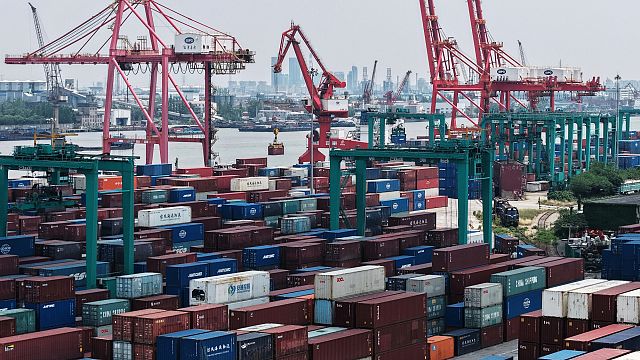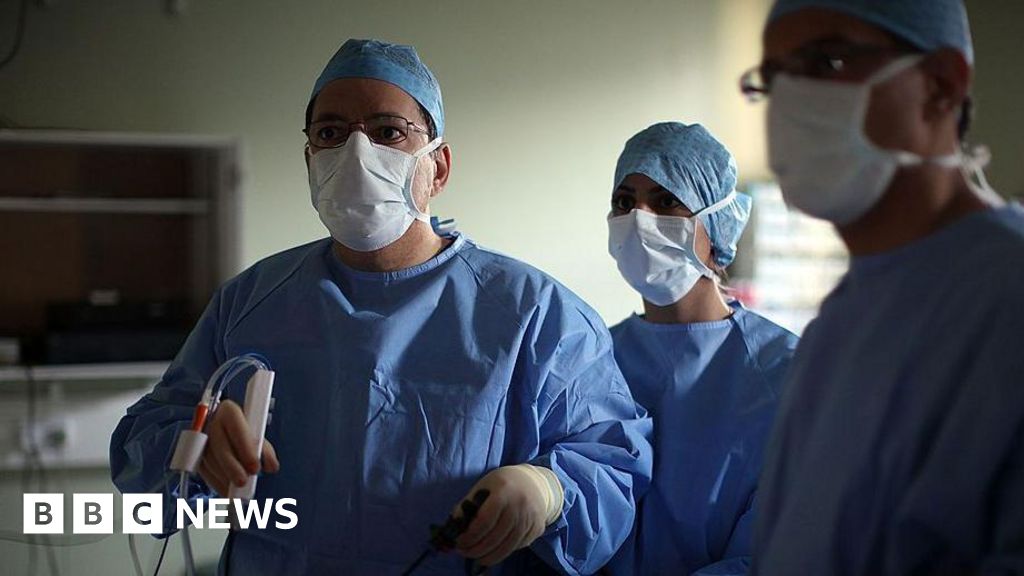Concerns Grow Over Dire Conditions in Immigrant Detention

Far from public view, the toll of the Trump administration’s crackdown on immigration is unfolding in overcrowded detention facilities across the country.
Some immigrants have gone a week or more without showers. Others sleep pressed tightly together on bare floors. Medications for diabetes, high blood pressure and other chronic health problems are often going unprovided. In New York and Los Angeles, people have been held for days in cramped rooms designed for brief processing, not prolonged confinement, and their lawyers and family members have remained in the dark about their whereabouts.
The nation’s immigration detention system is buckling under the weight of record numbers as the Trump administration intensifies its enforcement agenda with raids on workplaces and arrests at immigration courts. More than 56,000 immigrants were in government custody on June 15, exceeding the current capacity of 41,000.
“These are the worst conditions I have seen in my 20-year career,” said Paul Chavez, litigation and advocacy director at Americans for Immigrant Justice in Florida, which represents detainees. “Conditions were never great, but this is horrendous.”
At least 10 immigrants have died in ICE custody in the six months since Jan. 1, including two at a facility in Miami, the Krome detention center, where detainees earlier this month formed a human “S.O.S.” sign in the yard. At least two of the deaths were suicides, in Arizona and Georgia. (An average of about seven deaths a year occurred in ICE custody during the four years of the Biden administration.)
Immigration detentions have soared since late May, when Stephen Miller, the White House aide overseeing immigration policy, set a goal of 3,000 arrests per day.
To accommodate the swelling numbers, the administration has expanded contracts with prison operators and pushed for a substantial funding increase to secure additional capacity. The House version of the budget reconciliation bill proposes $45 billion for immigration detention, more than 10 times the current budget.
Many immigrants already have outstanding deportation orders, and others agree to voluntarily leave the country. In those cases, ICE officials are able to swiftly put them on planes or buses out of the country. But many others are entitled to court hearings, which take time, and ICE is either releasing those detainees on bond, which also requires a court hearing, or holding them in custody if they are deemed a flight risk.
The Department of Homeland Security, which oversees ICE, categorically denied all claims of overcrowding and poor conditions at its facilities. A spokeswoman, Tricia McLaughlin, said in a statement that all detainees “are provided with proper meals, medical treatment, and have opportunities to communicate with their family members and lawyers.”
Ms. McLaughlin added that Kristi Noem, the homeland security secretary, had called on states and local government to help with beds and detention space, and she noted that multiple court rulings have led to delays in deporting immigrants.
“Despite a historic number of injunctions, D.H.S. is working rapidly overtime to remove these aliens from detention centers to their final destination — home,” Ms. McLaughlin said.
But interviews with more than two dozen former detainees, lawyers, family members and lawmakers suggest that conditions in facilities across the country have become unsanitary, intolerable and in some cases, for detainees with health problems, unsafe.
Marcelo Gomes, an 18-year-old Brazilian from Milford, Mass., was pulled over on his way to volleyball practice in late May. Mr. Gomes, who has lived in the United States on a long-expired visa since age 7, said in an interview that he spent six days in a windowless, overcrowded room at an ICE field office before being released on bond.
There was one toilet for 35 to 40 men, who had no privacy when using it, he said. They slept on the concrete floor in head-by-toe formation with aluminum blankets to cover them.
He lost seven pounds in six days, he said, because the food was poor and the portions tiny. “It was so bad,” he said, “I used water to drink it down.”
Mr. Gomes said he was not able to shower or change his clothes the entire time he was there.
At the Northwest Detention Center in Tacoma, Wash., run by the GEO Group, a private prison firm, conditions have deteriorated as the population has significantly increased, according to Global Rights Advocacy, a nonprofit, and La Resistencia, a grass-roots group.
Alejandra Gonza, a human-rights lawyer, said that detainees told her that guards have been so overworked that they have delivered food close to midnight and have failed to provide yard time or disburse funds sent by their families to buy food, hygiene products and make phone calls.
She said she knew of some detainees who had been placed in prolonged solitary confinement or on suicide watch after complaining about conditions.
In Alaska, immigrants transferred from the Tacoma facility have been locked up in a state corrections facility in Anchorage.
“We are very concerned about the mental health and well-being of these individuals,” Cindy Woods, a lawyer at the A.C.L.U. of Alaska, said in testimony to the State Legislature last week.
“Many of them are struggling with the punitive setting and the isolation from family and lack of access to religious effects,” she said.
She said that detainees had been pepper-sprayed during a conflict over access to their belongings, and that they had regularly been placed on lockdown when the facility was understaffed.
After a tour that his staff members took in May to a facility in Estancia, N.M., Senator Martin Heinrich, a Democrat, reported that several detainees complained that they had been given few opportunities to shower, had been limited to two bottles of drinking water per day and were unable to flush their toilets for days at a time.
A California lawmaker, Representative Judy Chu, posted on X that she had visited a detention center in the remote desert town of Adelanto and seen detainees “held in filthy, inhumane conditions” who had been unable to communicate with lawyers or family members.
“They were not able to change their underwear for 10 days,” she said in a video.
In a statement, Christopher V. Ferreira, a GEO Group spokesman, said that facilities run by GEO like those in California, Pennsylvania and Washington, provided round-the-clock medical care, proper diets and visitation services. Mr. Ferreira said the detention centers were monitored by federal overseers to ensure they met strict standards on food, safety and health care.
“Our contracts also set strict limits on a facility’s capacity,” he said. “Simply put, our facilities are never overcrowded.”
Immigrants have been locked up for several days at a time at an ICE processing facility in the basement of a federal building in downtown Los Angeles that is intended to hold people for less than 12 hours, until they are released or transferred to a detention center.
“They’re packing people in there as if they were sardines,” said Mark Rosenbaum, a lawyer with Public Counsel, a legal nonprofit. “It’s a horror show.”
He said ICE authorities were preventing people from contacting lawyers and urging them to agree to swift deportation. “It’s a no-constitutional-rights zone,” he said.
Javier, 55, a Mexican day laborer who was arrested by agents in front of a doughnut shop in Pasadena, Calif., at 5:40 a.m. last week, said that about 60 men were jammed into the frigid, filthy space downtown.
“We felt like we were in a cage,” said Javier, who has lived in the United States for 28 years but did not want his last name used to avoid jeopardizing his immigration case. “They would take out five men and bring in 10 more.”
He said there was “utter despair and fear” in the room. The immigrants were forced to share one foul toilet; the other was out of order.
Javier was transferred to Adelanto, but lawyers with Immigrant Defenders Law Center, a nonprofit, secured his release because he is undergoing treatment for cancer.
In an industrial corner near Newark, four men escaped this month from the Delaney Hall detention facility after a melee broke out over the deteriorating conditions, according to lawyers who spoke with their detainee clients. Gwyneth Hesser, a lawyer with the Bronx Defenders, a nonprofit, said that her diabetic client now being held there could face “a life-threatening” situation without the diet and medical attention needed to manage his condition.
“He can’t eat bread or carbs, and that’s almost all they’ve given him,” Ms. Hesser said.
He has not received insulin regularly, she said. On June 16, he was found lying on the floor after his glucose level spiked, according to Ms. Hesser, who reviewed medical records of the incident.
In New York, immigration lawyers and federal lawmakers have struggled to gain access to the 10th floor of a federal building in Lower Manhattan, another intake center designed to hold immigrants for just a few hours. In recent weeks, lawyers said, their clients have reported being forced to sleep on the floor or on benches during days-long stays.
As with other detainees around the country, many who start off in Manhattan are quickly transferred out.
Anne Pilsbury, a lawyer in New York City, said that her client, a Honduran man who has lived in the United States for years, was handcuffed in front of her when he reported for an ICE check-in on June 9. She later learned that he had been held in the Lower Manhattan building overnight and sent to a jail on Long Island the next day.
“From that point, every time I checked the government’s detainee locator system, it would either have no information or it would show a new jail,” she said, “but when I called that facility, they would tell me he had been moved.”
Since being detained, the man, who is a construction worker and father of four children, has been held in Pennsylvania, Texas and Ohio.
Raiza, whose 20-year-old son was arrested at immigration court in Manhattan in May, setting off protests, said he was subsequently transferred from New York to Texas to Louisiana to Pennsylvania.
He also described unsavory conditions. At the Moshannon Valley Processing Center in Philipsburg, Pa., he told his mother during phone calls that he had spotted worms in the sink they used to drink water and was served rotten food.
Cynthia Myers, a Chicago woman whose husband was detained while awaiting asylum, said he was placed in an overcrowded facility in Monroe, La. Detainees there, he told her, were “constantly intimidated and pressured by staff to self-deport, with no regard for their rights or due process.”
Several of those interviewed said that ICE officials appeared to be trying to free up space by encouraging detainees to accept quick deportation.
A lawyer in Arizona, Nera Shefer, said that some of her clients had recently been offered $1,000 by the authorities if they agreed to immediate voluntary departure. She said all of them had declined.
“It seems they are randomly picking people, and telling them, ‘You want to leave? We’ll pay you because we need your bed,’” she said.
Steven Richand Albert Sun contributed reporting.
What's Your Reaction?
 Like
0
Like
0
 Dislike
0
Dislike
0
 Love
0
Love
0
 Funny
0
Funny
0
 Angry
0
Angry
0
 Sad
0
Sad
0
 Wow
0
Wow
0









































